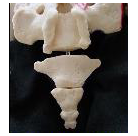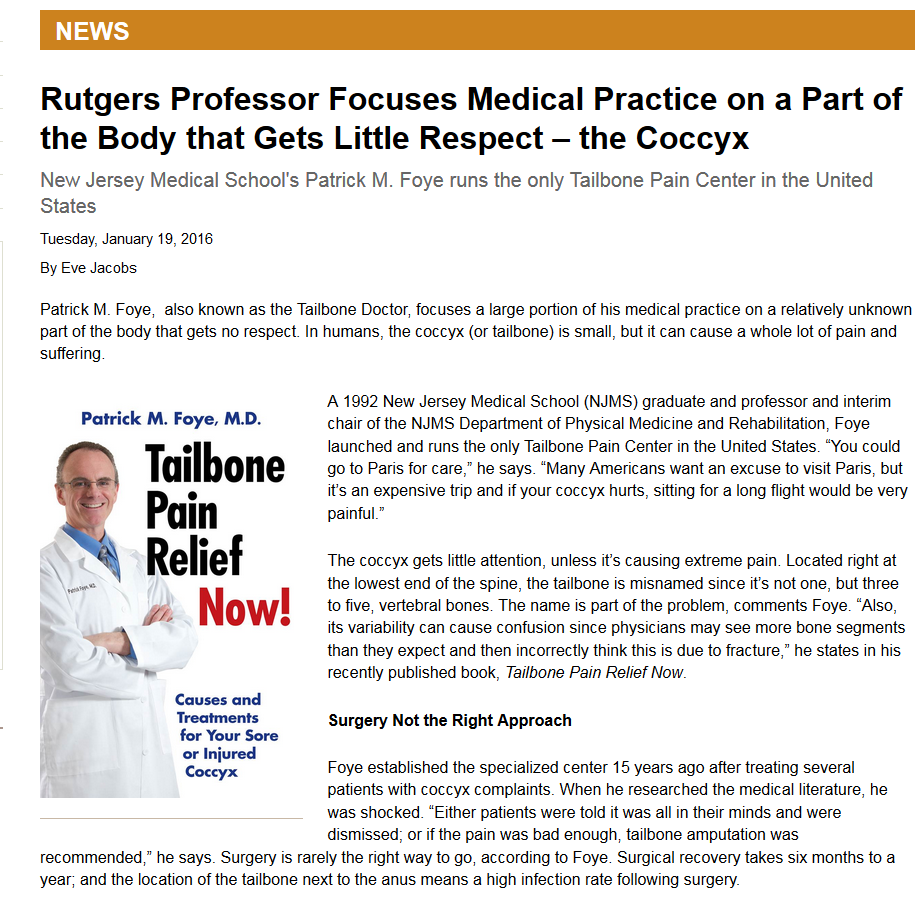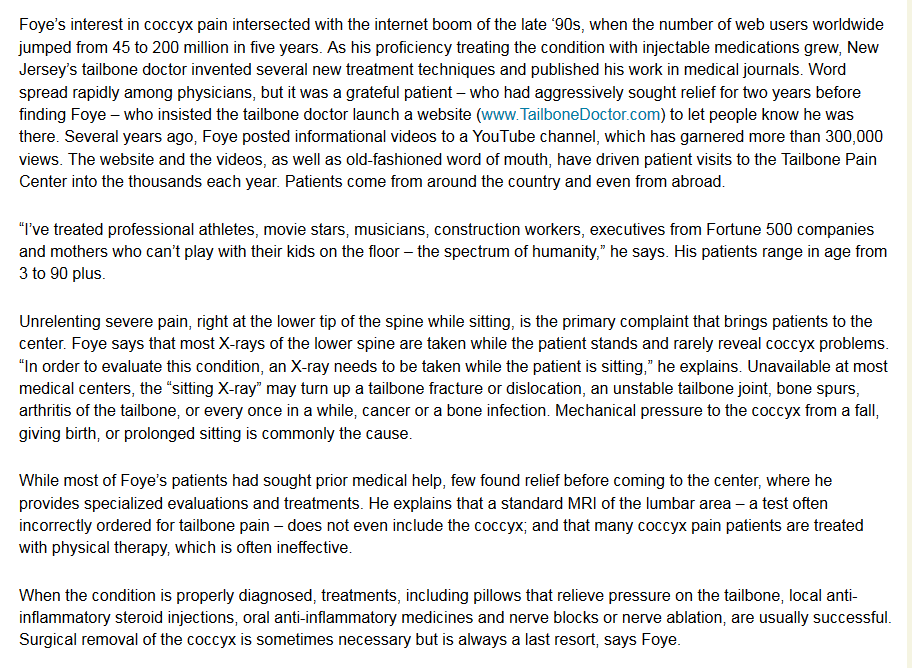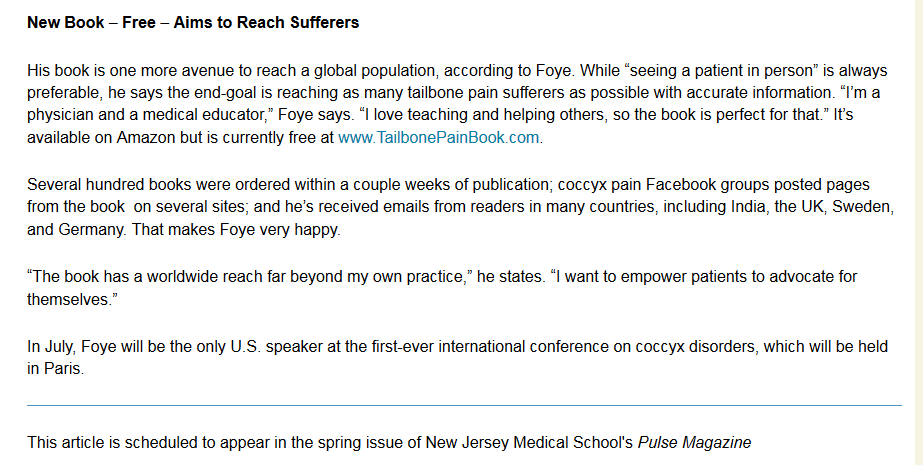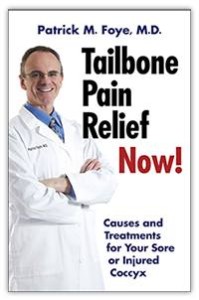Below is an article published by Rutgers University regarding Patrick Foye, M.D., and his Tailbone Pain Center.
The original article is posted here: http://news.rutgers.edu/news/rutgers-professor-focuses-medical-practice-part-body-gets-little-respect-%E2%80%93-coccyx/20160120#.WYEY71EpASK
Here is the non-formatted text:
Rutgers Professor Focuses Medical Practice on a Part of the Body that Gets Little Respect – the Coccyx
Patrick M. Foye, also known as the Tailbone Doctor, focuses a large portion of his medical practice on a relatively unknown part of the body that gets no respect. In humans, the coccyx (or tailbone) is small, but it can cause a whole lot of pain and suffering.
A 1992 New Jersey Medical School (NJMS) graduate and professor and interim chair of the NJMS Department of Physical Medicine and Rehabilitation, Foye launched and runs the only Tailbone Pain Center in the United States. “You could go to Paris for care,” he says. “Many Americans want an excuse to visit Paris, but it’s an expensive trip and if your coccyx hurts, sitting for a long flight would be very painful.”The coccyx gets little attention, unless it’s causing extreme pain. Located right at the lowest end of the spine, the tailbone is misnamed since it’s not one, but three to five, vertebral bones. The name is part of the problem, comments Foye. “Also, its variability can cause confusion since physicians may see more bone segments than they expect and then incorrectly think this is due to fracture,” he states in his recently published book, Tailbone Pain Relief Now.
Surgery Not the Right Approach
Foye established the specialized center 15 years ago after treating several patients with coccyx complaints. When he researched the medical literature, he was shocked. “Either patients were told it was all in their minds and were dismissed; or if the pain was bad enough, tailbone amputation was recommended,” he says. Surgery is rarely the right way to go, according to Foye. Surgical recovery takes six months to a year; and the location of the tailbone next to the anus means a high infection rate following surgery.
Foye’s interest in coccyx pain intersected with the internet boom of the late ‘90s, when the number of web users worldwide jumped from 45 to 200 million in five years. As his proficiency treating the condition with injectable medications grew, New Jersey’s tailbone doctor invented several new treatment techniques and published his work in medical journals. Word spread rapidly among physicians, but it was a grateful patient – who had aggressively sought relief for two years before finding Foye – who insisted the tailbone doctor launch a website (www.TailboneDoctor.com) to let people know he was there. Several years ago, Foye posted informational videos to a YouTube channel, which has garnered more than 300,000 views. The website and the videos, as well as old-fashioned word of mouth, have driven patient visits to the Tailbone Pain Center into the thousands each year. Patients come from around the country and even from abroad.
“I’ve treated professional athletes, movie stars, musicians, construction workers, executives from Fortune 500 companies and mothers who can’t play with their kids on the floor – the spectrum of humanity,” he says. His patients range in age from 3 to 90 plus.
Unrelenting severe pain, right at the lower tip of the spine while sitting, is the primary complaint that brings patients to the center. Foye says that most X-rays of the lower spine are taken while the patient stands and rarely reveal coccyx problems. “In order to evaluate this condition, an X-ray needs to be taken while the patient is sitting,” he explains. Unavailable at most medical centers, the “sitting X-ray” may turn up a tailbone fracture or dislocation, an unstable tailbone joint, bone spurs, arthritis of the tailbone, or every once in a while, cancer or a bone infection. Mechanical pressure to the coccyx from a fall, giving birth, or prolonged sitting is commonly the cause.
While most of Foye’s patients had sought prior medical help, few found relief before coming to the center, where he provides specialized evaluations and treatments. He explains that a standard MRI of the lumbar area – a test often incorrectly ordered for tailbone pain – does not even include the coccyx; and that many coccyx pain patients are treated with physical therapy, which is often ineffective.
When the condition is properly diagnosed, treatments, including pillows that relieve pressure on the tailbone, local anti-inflammatory steroid injections, oral anti-inflammatory medicines and nerve blocks or nerve ablation, are usually successful. Surgical removal of the coccyx is sometimes necessary but is always a last resort, says Foye.
New Book – Free – Aims to Reach Sufferers
His book is one more avenue to reach a global population, according to Foye. While “seeing a patient in person” is always preferable, he says the end-goal is reaching as many tailbone pain sufferers as possible with accurate information. “I’m a physician and a medical educator,” Foye says. “I love teaching and helping others, so the book is perfect for that.” It’s available on Amazon but is currently free at www.TailbonePainBook.com.
Several hundred books were ordered within a couple weeks of publication; coccyx pain Facebook groups posted pages from the book on several sites; and he’s received emails from readers in many countries, including India, the UK, Sweden, and Germany. That makes Foye very happy.
“The book has a worldwide reach far beyond my own practice,” he states. “I want to empower patients to advocate for themselves.”
In July, Foye will be the only U.S. speaker at the first-ever international conference on coccyx disorders, which will be held in Paris.
This article appeared in the spring issue of New Jersey Medical School’s Pulse Magazine
To come to Dr. Foye’s Tailbone Pain Center:
- Get expert medical care for your tailbone problem. Here’s what you need know: https://tailbonedoctor.com/prepare-for-your-visit/
Tailbone Pain Book:
To get your copy of Dr. Foye’s book, “Tailbone Pain Relief Now!” click on this link: www.TailbonePainBook.com
- Coccygectomy: Expected Recovery and Return to Work after surgery for coccyx pain, tailbone pain. - November 28, 2023
- PRP Platelet Rich Plasma or Prolotherapy for Tailbone Pain, Coccyx Pain - October 25, 2023
- Reasons for Normal X-rays and MRI Despite Tailbone Pain, Coccyx Pain - October 3, 2023
